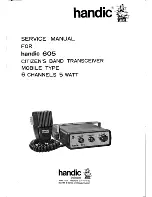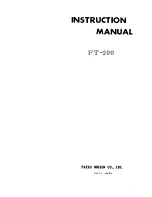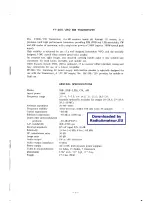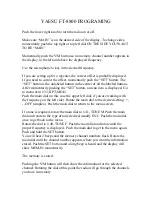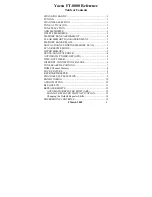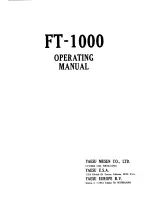
FM100B
•
7
frequency while also helping you to determine if you have L1 adjusted properly!
Normally if the PLL is locked and L1 is tuned properly, we know what the
control voltage will be to achieve the requested frequency by characterizing the
PLL loop voltage versus frequency. If we had requested 108.0 MHz, we know
the PLL control voltage should be around 8.9 VDC to be locked. If it is not
within that range, the locked LED will not light on the display.
What are all those additional parts in the VCO for? These allow our composite
stereo or mono signal from pin 5 of U2 to be placed on our carrier signal (the
frequency you selected). By adding an extra variable capacitor D2 (another
varactor diode) along with C9 into the VCO circuitry, the composite signal is fed
in to the VCO at a specific level after dividing it by R6 and R7. As the audio
swings positive and negative, the frequency goes up and down at the same
rate the audio does. This is in turn called frequency modulation (FM) due to the
frequency shifting back and forth with reference to your audio signal!
In order to get our locked signal out over the air we have to boost the output of
our VCO a bit. To do this we use a fancy new part we call the GAL5. This is
actually a very well-matched (RF-wise) amplifier with several transistors inside
that give us plenty of RF gain without unwanted signals being added in. It by
itself has enough gain to give us our 25 mW output (R3 turned fully CW for full
output). It also provides plenty of level for some further amplification with the
export model (FM100BEX).
Because our amplifier is not truly linear, it introduces some harmonics.
Harmonics are multiples of the primary frequency. The primary one we are
trying to get rid of is the second harmonic (F x 2) which in our case winds up in
the aircraft band. It is extremely important for us not to interfere with ANY other
transmissions in ANY band. The best filter for the job is the low-pass filter
consisting of L3, C63, C59, C67, L4, C64, L5, and C68. This has an upper
cutoff frequency at 110 MHz to prevent anything above from getting out onto
the antenna and over the air.
U2 (the BA1415 FM stereo transmitter IC) is what does all the work of creating
your stereo subcarrier as well doctoring your audio signals for transmission.
This new version of stereo modulator chip (the old one was a BA1404) has
some impressive capabilities and fantastic sound as compared to the older
versions. For one it contains a limiter to prevent over-modulation, as well as the
pre-emphasis circuitry and some low pass filtering on the audio. It is basically
an entire professional transmitter on a chip! All of the required low-pass audio
filtering we wanted could not be performed within the chip so we added some
more external filtering to give it an even better, richer sound.
Now that we are done with the RF section, let’s look into the audio circuitry
starting at the inputs and going forward to U2. We are going to take a closer
look at the microphone amplifier, audio mixer, audio switcher, and peak hold
meters to find out the purpose of each. For ease of description we will only
Содержание FM100B
Страница 17: ...FM100B 17 SECTION LAYOUT ON MAIN BOARD B C D1 D2 H E G F I ...
Страница 27: ...FM100B 27 DISPLAY SCHEMATIC ...
Страница 35: ...FM100B 35 MAIN BOARD PARTS LAYOUT ...
Страница 44: ...FM100B 44 REAR PANEL WIRING PICTURES AC Input and RF Output Fuse Wiring Close up ...
Страница 54: ...FM100B 54 ...
Страница 55: ...FM100B 55 ...



























